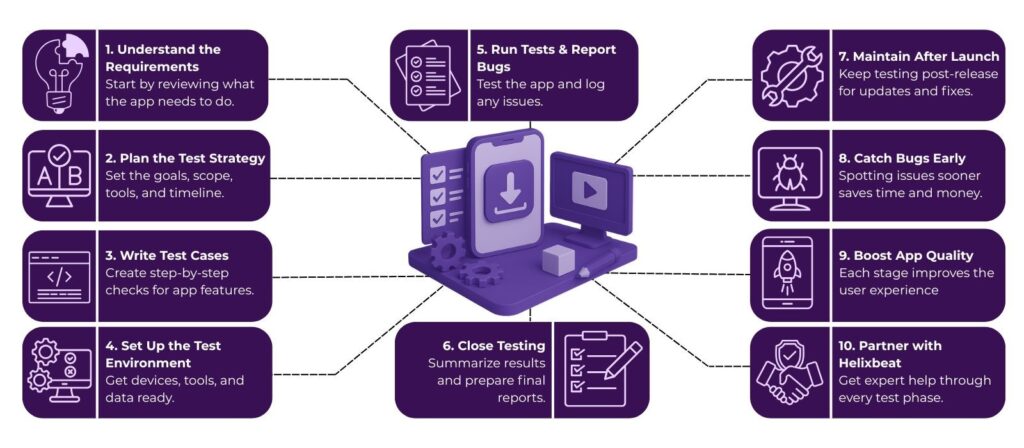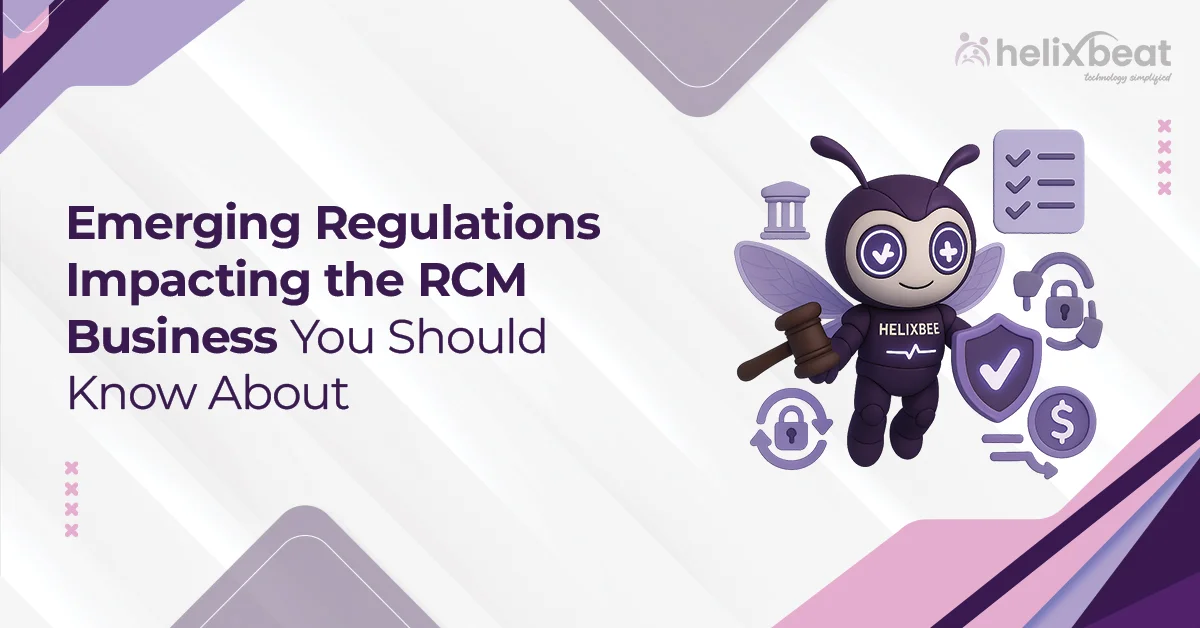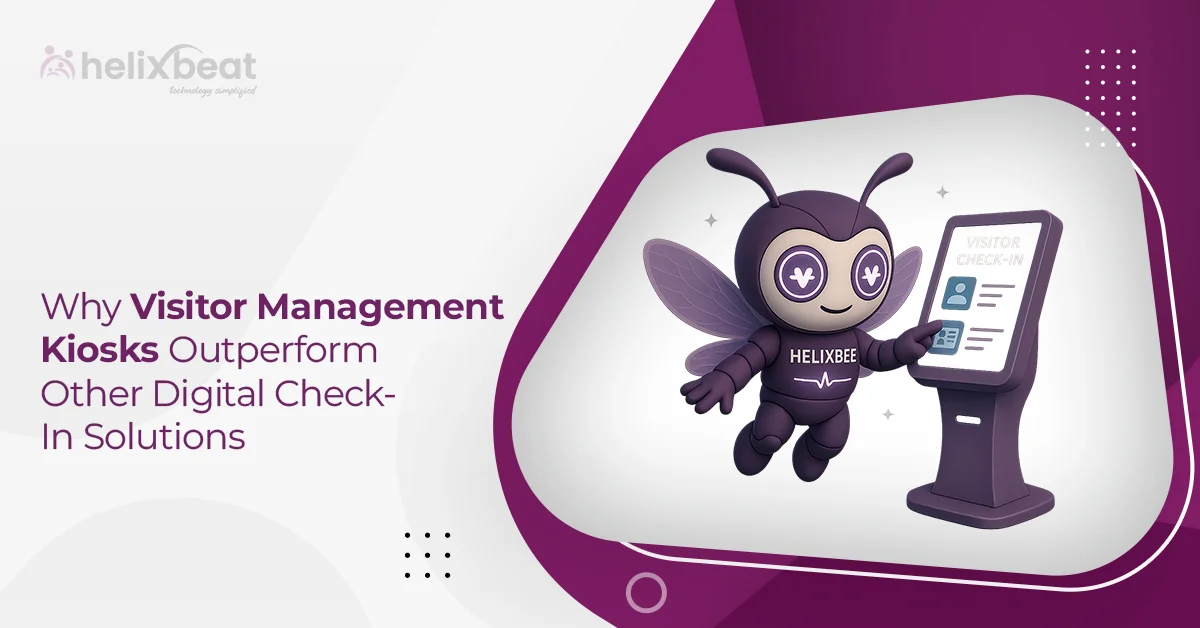Think about ordering food through an app that suddenly freezes or sends the wrong delivery address. Frustrating, right? Just like that, if an app or software isn’t tested well before launch, users can face problems that hurt the business’s reputation and sales.
The software testing lifecycle is like a step-by-step checklist that makes sure the app works properly before it reaches users. It helps catch mistakes early, fixes bugs through the bug life cycle, and makes the app smooth and reliable.
Helixbeat understands how important this process is. We work closely with businesses to follow every stage of the testing lifecycle carefully, making sure apps are ready to perform well and keep users happy from the moment they hit “download”. In this blog, you’ll learn more about software testing lifecycle and its seven stages in app development.

Table of Contents
What is the Software Testing Lifecycle?
The Software Testing Lifecycle (STLC) is a series of well-defined phases that guide the testing process of a software application. It ensures that the software meets the desired quality standards and works as expected before it reaches users. STLC covers everything from understanding requirements and planning tests to executing them, reporting bugs, and finally closing the testing process.
Each stage in the lifecycle focuses on a specific set of tasks, making the entire testing process organized, efficient, and effective. By following the STLC, businesses can catch defects early, improve software quality, reduce costs, and deliver a reliable product that users can trust.
7 Stages of Software Testing Lifecycle
The software testing lifecycle provides a clear, step-by-step plan to organize and manage testing activities. It helps teams catch issues early and deliver reliable software.
1. Requirement Analysis in Software Testing Lifecycle
The first stage focuses on understanding the software requirements from both functional and testing perspectives. Testers review the specifications to identify what needs to be tested and prepare a list of testing requirements. Clear understanding at this stage helps avoid confusion and ensures that testing efforts align with business goals.
During this phase, testers also identify testable requirements and may communicate with stakeholders like developers and business analysts to clarify doubts. This collaboration sets a strong foundation for creating effective test plans and cases later.
2. Test Planning and Strategy Development
In this stage, the testing team creates a detailed test plan that outlines the overall testing strategy, scope, resources, schedule, and deliverables. The plan defines the testing objectives and approaches, helping the team stay organized and focused throughout the process.
Test planning also involves estimating costs, assigning roles, selecting tools, and identifying risks. A solid test plan acts as a roadmap, guiding the testing team and ensuring smooth execution in later stages.
3. Test Case Design and Development
Once the plan is ready, testers design detailed test cases that describe the input, action, and expected output for each scenario. These test cases serve as instructions to verify if the software behaves correctly under different conditions.
In addition to test cases, testers prepare the test data needed to execute these tests. Designing comprehensive and clear test cases is essential to cover all possible user scenarios and catch potential defects early.
4. Environment Setup for Software Testing
Before actual testing begins, the testing environment is set up to mimic the production environment as closely as possible. This includes hardware, software, network configurations, and databases required to execute the test cases.
A well-prepared environment ensures that tests are reliable and results accurately reflect real-world conditions. If the environment isn’t ready, testing can be delayed or yield misleading results.
5. Test Execution and Defect Reporting
Testers execute the test cases and record the outcomes, comparing actual results with expected ones. Whenever a defect or bug is found, it is logged with detailed information to help developers understand and fix it.
Each bug then follows its own journey, known as the bug life cycle, which includes stages like identification, assignment, fixing, retesting, and closure. Managing this cycle efficiently ensures bugs are resolved promptly, and the software’s quality improves steadily.
6. Test Closure Activities
After testing is complete, the team reviews all testing activities and results to ensure objectives have been met. This phase involves documenting lessons learned, finalizing reports, and confirming that all defects have been addressed or accepted.
Test closure also includes archiving test artefacts and releasing testing resources. This stage helps improve future projects by reflecting on successes and areas for improvement.
7. Continuous Monitoring and Maintenance
Even after release, the software requires ongoing monitoring and maintenance to address any issues users may face. Feedback from users and new requirements can trigger additional testing cycles to keep the software up-to-date and secure.
Continuous testing and maintenance ensure the software remains reliable over time, adapting to changes and providing users with a consistent experience.
Following the seven stages of the software testing lifecycle ensures thorough testing and effective bug management, leading to high-quality, user-ready software.
What are the Benefits of Software Testing Lifecycle?
- Improves Software Quality: Ensures thorough testing at each stage, leading to a more reliable and bug-free product.
- Early Defect Detection: Identifies issues early in the development process, reducing costly fixes later.
- Organized Testing Process: Provides a structured approach that helps teams manage testing activities efficiently.
- Better Resource Management: Helps allocate testing resources, tools, and timelines effectively to meet project goals.
- Enhances Customer Satisfaction: Delivers high-quality software that meets user expectations and builds trust.
What are the Entry and Exit Criteria in STLC?
| Stage/Phase | Entry Criteria | Exit Criteria |
| Requirement Analysis | Requirement documents are complete and available. | Requirements have been reviewed and analyzed for testability. |
| Testers have access to business and functional requirements. | Testable requirements are identified and any ambiguities clarified with stakeholders. | |
| Test Planning | Requirement analysis is completed. | Test plan including scope, resources, timelines, and risks is created and approved. |
| Test resources (people, tools) are identified and allocated. | Testing strategy and approach are finalized and communicated to the team. | |
| Test Case Design | Approved test plan and clear requirements are available. | Detailed test cases and test data are designed, reviewed, and signed off. |
| Testers have clarified any doubts related to requirements. | Test coverage meets requirements and test cases cover all functional and non-functional scenarios. | |
| Test Environment Setup | Test cases and data are ready for execution. | Test environment is configured, validated, and ready to simulate real-world conditions. |
| Necessary hardware, software, and network setups are identified and procured. | Environment stability confirmed and access provided to the testing team. | |
| Test Execution | Test environment is ready and accessible. | All planned test cases are executed and results documented. |
| Testers have test cases and data in hand. | Defects are logged, tracked, retested, and closed as per the bug life cycle process. | |
| Test Closure | Test execution is completed. | Test summary reports are prepared, covering coverage, defects, and quality metrics. |
| All critical and high-priority defects are resolved or accepted by stakeholders. | Lessons learned are documented, and testing deliverables are archived for future reference. |
Best Practices for Succеssful STLC
To get the most out of the software testing lifecycle, following proven best practices is essential. These practices help streamline the process, reduce errors, and improve collaboration leading to higher-quality software delivered on time.
- Start with Clear and Early Requirement Analysis to avoid misunderstandings and set testing goals accurately.
- Develop Detailed Test Plans and Maintain Thorough Documentation for organized and efficient testing.
- Utilise Robust Bug Tracking to Manage Defects Effectively throughout the Entire Bug Life Cycle.
- Promote Continuous Communication and Collaboration between testers, developers, and stakeholders for smooth workflow.
A well-executed software testing lifecycle is key to delivering reliable, user-friendly software that meets business goals and customer expectations. By following each stage carefully from requirement analysis to test closure and ongoing maintenance teams can catch defects early and ensure smooth, high-quality product releases.
Helixbeat’s expert software testing services are designed to guide your project through every phase of the testing lifecycle with accuracy and care. Our dedicated team leverages advanced testing methodologies and efficient bug management to help you deliver flawless applications faster.
Partner with Helixbeat to experience a seamless testing process that guarantees software quality and user satisfaction every step of the way.
FAQ:
1. What is a test cycle in QA?
A test cycle in QA is a complete round of testing activities that includes planning, designing, executing test cases, and reporting defects. It represents one full pass of testing on a software build to verify functionality and quality.
2. What do you mean by bug life cycle in software testing?
The bug life cycle is the process a defect goes through from discovery to resolution, including reporting, fixing, retesting, and closure. It helps track and manage bugs to improve software quality.
3. What is SDLC and STLC in software testing?
SDLC (Software Development Life Cycle) is the overall process of planning, creating, testing, and deploying software. STLC (Software Testing Life Cycle) is a subset of SDLC focused specifically on testing activities to verify and validate the software quality.
4. What is full cycle testing?
Full cycle testing refers to the comprehensive testing of an application throughout all stages of development, covering unit tests, integration tests, system tests, and user acceptance tests to ensure complete coverage.
5. What are types of testing?
Types of testing include functional testing, non-functional testing, regression testing, smoke testing, integration testing, system testing, user acceptance testing (UAT), performance testing, and security testing, among others.
6. What is a bug in QA testing?
A bug in QA testing is a defect or error in software that causes it to produce incorrect or unexpected results, or to behave in unintended ways. Bugs are identified during testing and tracked through the bug life cycle until fixed.














